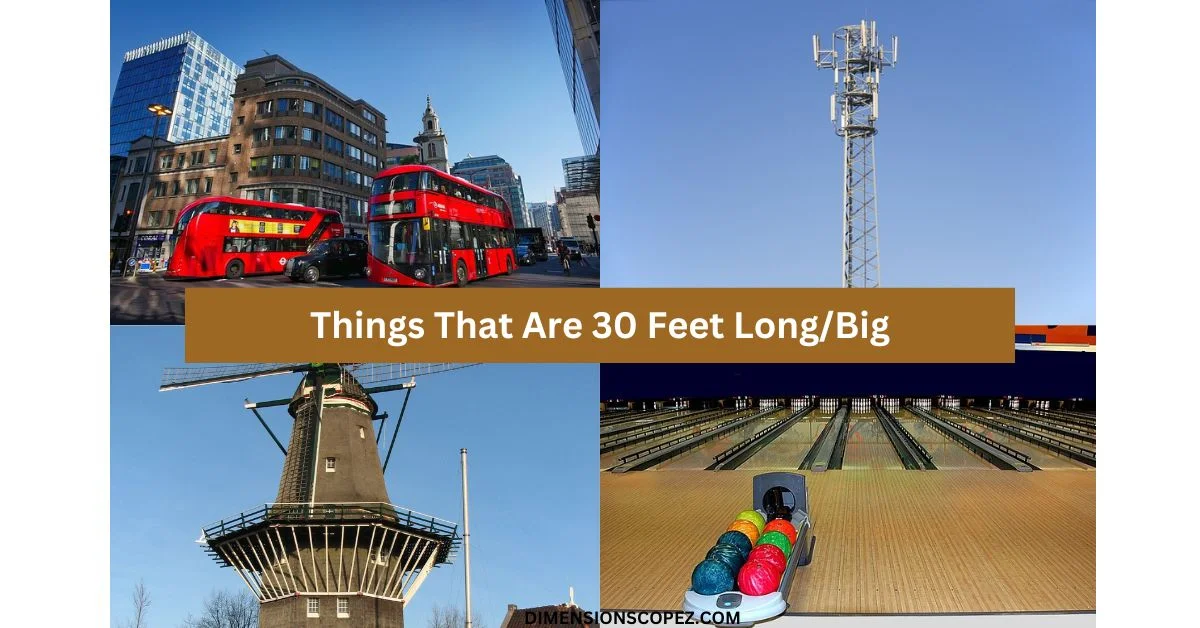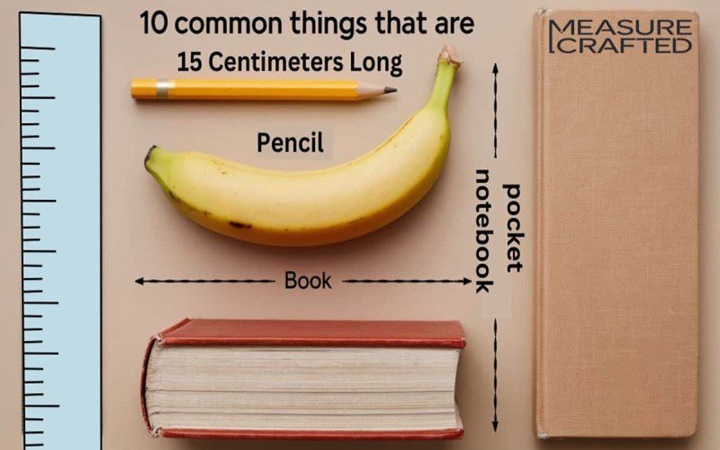9 Things That Are 30 Feet Long/Big
We measure distances, heights, and sizes to determine the magnitude of objects and spaces around us. Among these measurements, 30 feet is a notable example, representing a substantial length that can not be easy to visualize.
In this study, we explore the number thirty feet and find out what it means in different situations. From the real to the imagined, we want to shed light on how big this number is and how it affects our daily lives. Come with us on this journey as we try to figure out what things 30 feet or longer are and how they work. We might give you ideas and surprises along the way.
How Long is 30 Feet?
Keep in mind that thirty feet is equivalent to 9.144 meters or 360 inches.
To get a sense of thirty feet’ length, imagine laying out ten standard yoga mats end to end, as each mat typically measures about three feet wide. Alternatively, consider the average school bus, which stretches approximately 45 feet long. In this comparison, 30 feet is roughly two-thirds the length of that bus.
This distance isn’t just a statistic; As a real thing, we might walk it every day without even realizing it, such as crossing a small parking lot or moving through a spacious room. This size serves as a baseline, a building block of understanding we’ll use to compare other objects and distances.
How Tall is 30 Feet Compared to a Person?
To visualize how tall 30 feet is compared to a person, picture standing next to a three-story building. On average, each story in a building is about 10 feet high so a 30-foot tall structure would be equivalent to the height of a typical three-story residential building.
In more relatable terms, if an average person stands about 6 feet tall, thirty feet would be as tall as five adults standing on each other’s shoulders. This helps highlight how towering a 30-foot height is compared to a person’s everyday sight.
How High is 30 Feet in the Air?
To envision 30 feet off the ground, think about the same height as a standard telephone pole, which is usually a bit taller, around 36 feet. Thirty feet is also comparable to the canopy height of a mature oak tree. For those familiar with public diving platforms, it’s similar to the height from which intermediate divers leap.
This height offers a tangible sense of elevation that, while not extreme, is substantial enough to give most people a pause if they were to look down. This measurement could also represent the vertical climb on a rock climbing wall in a gym, making it a good benchmark for understanding moderate heights in outdoor and recreational activities.
How Far is 30 Feet in a House?
In a typical home, thirty feet can span several rooms or stretch from one end of the house to the other, depending on the house’s layout and size. For example, thirty feet could cover the entire length of a big sitting room or hallway, creating a substantial living area.
This measurement can also be compared to about ten paces walked by an average adult, which makes it a helpful reference when considering the layout of furniture or planning renovations. It’s a distance that might cover the space from the back door of a kitchen to the far end of the living room in many homes, giving you an idea of how connected or open up different parts of a house can feel.
Here are things that measure approximately thirty feet long.
1. Half of the Cricket Pitch

Cricket games are played on a field with a 22 yards or 20 meters long pitch in the middle shaped like a rectangle. Batting and bowling are the main parts of the game. One team hits the ball and tries to score runs, while the other team fields and bowls and tries to get rid of the batters and limit the runs scored.
For cricket, the pitch is 66 feet long. This is where the main action between the bowler and the batter happens. This means 30 feet is just under half the length of a cricket pitch.
When watching a game, envisioning this span can give you a better sense of the space and distance that players cover, particularly when running between the wickets. Understanding this measurement can enhance a spectator’s appreciation of the agility and speed required in cricket.
2. London Bus

The London bus, particularly the famous red double-decker, symbolizes public transportation in London, England. These buses are crucial for daily commuting and serve as a tourist attraction. When considering objects that are approximately 30 feet long, a London bus is a practical example, as it measures about 27.5 feet in length.
This iconic red bus is slightly shorter than thirty feet, providing a real-world comparison that can be easily visualized by anyone who has seen these buses in movies or perhaps in person. This comparison helps put the everyday use of the 30-foot measurement into perspective.
Related: Things That Are About 25 Feet Long/Big
3. Three times the Height of the Christmas Tree

A Christmas tree is a decorated tree that is usually an evergreen conifer like a spruce, pine, fir, or a fake tree that looks real. It is associated with the holiday of Christmas. Generally, a big Christmas tree in a mall or public area will be about 10 feet tall. So, 30 feet would be the height of three of these Christmas trees stacked on top of each other.
A star or angel that looks like the Star of Bethlehem is usually placed on top of the lights, ornaments, and ribbons. In the 1600s, religious Christians in Germany were the first to decorate their Christmas trees and bring them into their homes. After that, many people in many parts of the world do it now.
4. ⅓ of De Gooyer

De Gooyer, a famous windmill in Amsterdam, stands at an impressive height of about 89 feet. This makes 30 feet approximately one-third of its total height. If you’ve ever seen this historic structure or similar large windmills, imagining cutting its height into three equal segments helps clarify the scale of thirty feet.
This portion of the windmill might include the height from its base to a part way up the tower or the first set of windows, providing a sense of grandeur and the towering nature of such architectural landmarks. Understanding this can enhance our awareness of historical engineering and architectural feats.
5. Half a Bowling Lane

A standard bowling lane, from the foul line to the headpin, measures about 62 feet in length. Therefore, if you consider half of this, it will be 31 feet, just one foot larger than 30 feet, and just under half the length of an entire bowling lane.
Thinking about thirty feet as half the lane can be a practical and easy way to conceptualize their throws or understand the kinetic energy involved if you are a bowler or a sports fan. People of all ages and skill levels like the sport and can be played competitively and casually. It’s common to see bowling alleys equipped with multiple lanes, allowing several groups to play simultaneously.
6. Three U-Haul Trucks

Many people rent U-Haul cars to move their stuff, whether short or long distance. U-Haul vehicles are easy to use, so anyone can use them for personal purposes without needing a special permit. Do-it-yourself movers like them because they are easy to find across North America and have a wide range of moving tools and accessories that make the process go more smoothly.
Based on the fact that a normal U-Haul moving truck can be about 10 feet long, stacking three of them end-to-end would give you about 30 feet. This visual helps show the length when thinking about tasks like moving or storage, where understanding space and size is crucial.
7. Telephone Pole

These poles are essential components of our utility infrastructure, supporting telephone wires, electrical power lines, and fiber optic cables for the internet and TV. A typical telephone pole stands around 36 feet tall, making 30 feet a slightly shorter measure.
They are common in urban and rural landscapes, often equipped with additional features like streetlights and traffic signals, making them integral to modern communication and utility services. It’s an example of the vertical scale within our urban or rural environments, and understanding this can give us a more excellent knowledge of the infrastructure that keeps our communication networks operational.
8. Six Adult Blue Whale’s Heart

Did you know an adult blue whale eats about 4 tons of krill daily while feeding? The blue whale is a baleen whale, and its main food is krill, which are small critters that look like shrimp.
The blue whale is the biggest animal living on Earth and even bigger than the biggest dinosaurs. An adult blue whale’s heart is about 5 feet long on average. So, if you put six of these hearts end to end, they would be about 30 feet long.
9. 3-Story Building

A three-story building is typically about 30 feet high, with each floor accounting for about 10 feet, including the ceiling and the floor thickness of the level above. This visual can be particularly relatable as many people live in or have visited a building of this size. Visualizing thirty feet as the height of a familiar residential or office building provides a practical understanding of this measurement.
It helps one gauge the scale of emergency ladders, fire safety planning, and even the daily exertion of climbing stairs. It also provides an architectural context that can be useful for those involved in building, real estate, or even rescue operations, linking the concept of height directly to lived experiences and safety considerations.
Final Thoughts
Through exploring what constitutes 30 feet, we’ve traversed a diverse landscape of dimensions, from everyday objects to magnificent natural phenomena. Whether half a cricket pitch, the iconic red London bus, or stacking three monumental U-Haul trucks, each comparison helps us measure the physical world and appreciate its scale and how we interact with space.
Understanding thirty feet through these varied examples enriches our daily perception of the mundane and the spectacular. So next time you pass a telephone pole or look up at a three-story building, remember these comparisons and think about the fascinating world of measurements surrounding us.







